We wrote, we wrote, or what to do when we are overtaken by tunnel syndrome
If you are reading these lines, it is only natural to assume that you spend at least a few hours a day on the computer, or even more. This mode of operation brings with it a fairly strong load on our hands, which can cause pain in the hands, wrists and fingers. Such pains are caused by the so-called "tunnel syndrome" (carpal tunnel syndrome, carpal tunnel syndrome, carpal tunnel syndrome) - a chronic disease.
In this article we will try to understand the causes of tunnel syndrome, possible ways of treatment and ways to prevent this undesirable phenomenon. This article will contain quite a few subjective deviations from the formal definitions and formulations that are available on various medical sites, since spending a lot of time behind the keyboard over the past eight years, I have tasted the effects of tunnel syndrome in all its manifestations.
So, what causes this unpleasant phenomenon? Carpal (tunnel) syndrome is caused by squeezing the nerve of the hand (median nerve), which passes through special channels formed by the bones and ligaments. Naturally, when squeezing the nerve, we feel pain, which can be felt in the joint of the hand, but not only in it. Now we will go through all the stages of the discussed syndrome and try to connect the physiological processes with what we can feel when working at the computer.
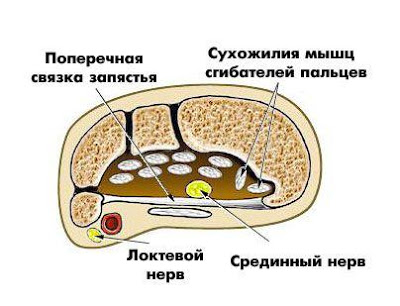

From personal experience, first there is a slight dull pain, numbness or discomfort in the joint of the hand after several hours of work. If you stop work and just stretch your arms, the pain disappears for half an hour - an hour. The unchanging position of the hand, along with intensive work, leads to stagnation of blood, which causes only unpleasant sensations at this stage.
')
If you do nothing and continue to work as before, then after a year or two the next stage will come - a burning sensation in the brush, which appears by the end of the working day and no longer passes as before, but continues to haunt us at home, two or three hours, moving gradually just dull, weak pain. This happens because of the thickened tendons, which are already inflamed and begin to put pressure on the nerve (the diameter of the channel has decreased) with a problematic position of the hand. At about the same time, pain may appear in the hand itself (the outer side of the palm) and in the phalanges of the fingers, especially the index and middle, which are most used when working with the mouse.
In addition to all the charms of working at a standard place of work, it becomes problematic to lift weights when the brush is in a certain position. Interestingly, the degree of pain does not depend on the severity of the load, but mainly only on the position of the arm. But we will not be distracted, we will go further.
In this position, our body will try to cope with an unfavorable position, and lymphatic fluid begins to accumulate between cartilage, designed to flush out the affected and inflamed cells. In the normal course of events, such a process reaches its goal (the cells are washed out) and the liquid dissolves itself. If the load on the hands is long, then inflammation, as you can already guess, does not stop, but quite the opposite. With this development of events, the natural treatment process itself can already lead to the opposite result - swelling of the lymphatic fluid in the joints. From personal experience, again, it can be determined with a high probability whether you have reached this stage or not. Tides of lymphatic fluid are most significant at night, so if the pain at night is stronger, you have already arrived at the destination station. Well, if the pain in the joints also wakes you up at night - “dry the oars, gentlemen,” it's time to do something urgently, otherwise the only way out will be an operation.
Before we discuss inpatient medical treatment, let's first see what we can do on our own, reduce the healing of our body to physiotherapy, or, in extreme cases, limit ourselves to outpatient treatment.
These exercises can / should be done every few hours, and each of them should be repeated many times, with a dozen or two.
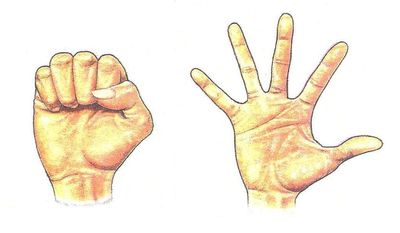
1. Strongly squeeze the fingers into a fist and also strongly release.
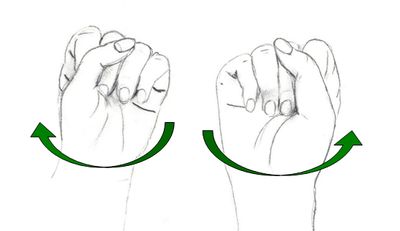
2. Clench fists and rotate first in one direction, then in the opposite direction.
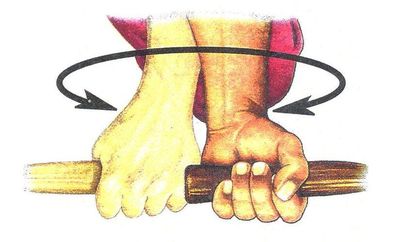
2a You can perform the same exercise with a special ball, inside which is a fast-rotating disk (for example, PowerBall or with any more or less heavy object). I had the opportunity to try such a thing — it resists noticeably changing the position of the ball along any axis, and thus trains the muscles and accelerates the blood more, which is what we achieve. You can rotate the hand not only along the axis of the elbow-wrist, as shown in the picture, but also completely arching the hand.
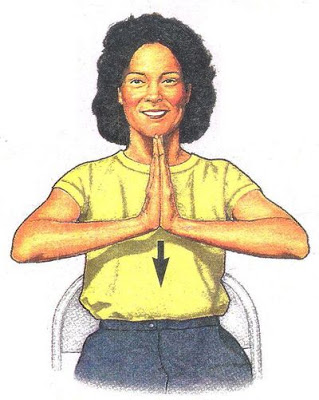
3. Press your palms together, spread your elbows to the sides, assuming a position like a prayer. Forearms in this position are parallel to the floor. Then, try to lower the palms as low as possible without opening them and leaving the elbows still high. It is likely that there will be pain in the hands, in the palms or even in the phalanges of the fingers, if the disease under discussion has already reached you. It is important not to put your hands far away from yourself.


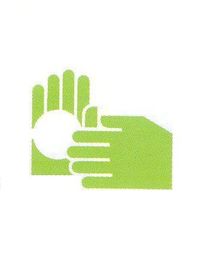
4. If you have a special soft ball (these are often distributed as free gifts at various gatherings and presentations) for hands, press it alternately with your fingers, palm and between your hands, as shown in the pictures.
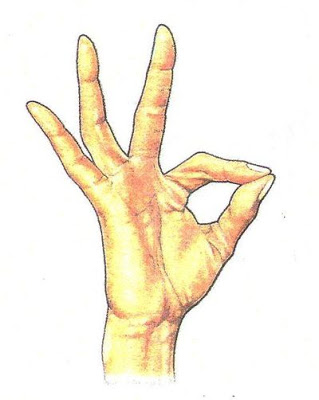
5. Repeat the previous exercise, but without the ball, resisting the thumb with all your fingers in turn.
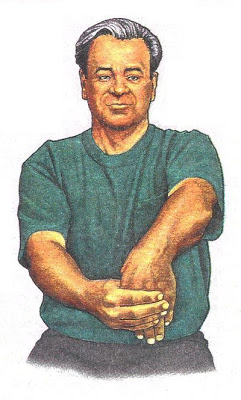
6. Straightening your arms in front of you, as shown in the picture, rest your hand on the palm. When resisting, try to straighten a bent palm.
It seems so far. Let's go further - what can be done at home, if the pain is noticeable when working, i.e. (see previous chapter) tendons are already inflamed.
The exercises that will be described here will border a little on “real” physiotherapy, but please tell me, why should we wait for someone and something if we can help ourselves? So let's start with the easiest, but again, from personal experience, the most effective.
1. Fill a deep bath with warm, almost hot, water and clenched fists, slowly rotate them in water. It is important that the water warms the hands high enough, above the hand joint. This exercise greatly relieves pain both at the initial stage and at the progressive stage. The optimal duration for this exercise is 10-15 minutes, no less. At the end, wrap your hands, including brushes, in a towel - do not cool them quickly. If the apartment is cold enough, then use even a warm scarf.
2. Repeating to some extent the previous exercise, you can put on the night alcohol warming compress, just do not make it strong, and then burn the skin on your hands - a most unpleasant experience.
3. Massage. In a situation where fingers and hands hurt from any effort, it will be difficult to massage yourself. It is best to ask someone, it does not require special skills, the main thing - the desire. It is necessary to massage the whole arm, starting from the outside of the palm, continuing upwards, the outer side of the forearm (trying to move in the middle of the arm, where there is a small cavity between the forearm bones).
4. I cannot say anything about the advice in this paragraph, neither for nor against, because I did not use this approach. If it helps you - well, if not - do not worry, water massage, namely, it will be discussed now, does not carry anything destructive. Hydromassage is offered as a treatment on some sites dedicated to this issue, and it is proposed to use it twice a day - in the morning (cool and warm water) for massaging the collar back, shoulder blades, shoulders, forearms and hands, and in the evening (only warm water) in the same way.
We are starting to quietly cross the border of self-treatment and outpatient treatment, because physical therapy, although not an active treatment, at least in my opinion, is nevertheless prescribed by a physician, and physiotherapy should be fully completed to achieve some kind of sane result. Everything that will be described in this chapter should not be taken as the recommended course of treatment, and all the more I hope that everyone understands that my personal experience does not in any way replace the full-fledged prescription of a doctor, a specialist in this matter, and responsible for the result thereof .
1. Again ... massage. Yes, as one of the means, physiotherapy will offer you a massage again. I do not know how much his location affects the quality of massage (in his office or at home), he helped me a little in both the first and second cases.
2. Warming paraffin baths. Remember the first paragraph of the home exercises? It is almost the same, but instead of hot water, you will be offered to dip your hands in hot paraffin and after two or three dipping they wrap their hands with a warm towel. The result will be the same - the joint and the tendons warm up, only here your hands will look like big ritual candles. There is nothing terrible in it, on the contrary, it is funny then to make such hand casts in a scale of 1: 1.
3. Shortwave heating. With this type of treatment, the joints of the hand are heated by radiation in the range of several giga-hertz (if I remember everything correctly). I did not like this business and I refused after one session. The personal microwave on my hands did not seem to me to be particularly useful, and deep warming can be achieved at home.
4. Exercises for the muscles of the arms and back. Sometimes the disease under discussion may occur due to improper posture during work, therefore, as one of the options for physiotherapy, you can be offered simple physical exercises, it all depends on your physique and posture. Since the proposed exercises are quite simple, there is not much point in describing them in detail. Yes, in my opinion, this item is quite a candidate for a transfer to the previous chapter - at home you can certainly wave with light dumbbells and stretch the gum.
Unfortunately, although most likely the opposite, I can not share personal experience in the issue of inpatient treatment. As far as I know, when edema of the lymphatic fluid, doctors suggest a puncture - an operation to extract excess fluid. Personally, this does not seem to me to be 100% correct, since the consequences, rather than the original cause, are eliminated. With completely neglected cases when the cartilage of the joint has been damaged or destroyed, various medications are offered, but this certainly requires an examination by a specialist, therefore our discussion of inpatient treatment will end approximately here.
We couldn’t call ourselves geeks if we had a pair of labeled aces up our sleeves to help us solve such problems, wouldn’t we? Well, if so, then it’s time to discuss and tell which gadgets are saving us in this position.
The easiest and most effective way to solve a problem is not to face it. The easiest way, fairly well known today, is a pad under the brush. The most commonly used gel pads and, it should be noted that even the cheapest of them do their job perfectly, straightening our joint of the brush as far as possible.
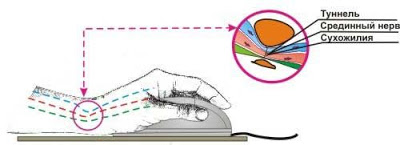
So wrong.

And so right.
But let's move on to more serious devices, and we'll start with keyboard modifications.
To date, there are three types of conventional ergonomic keyboards:
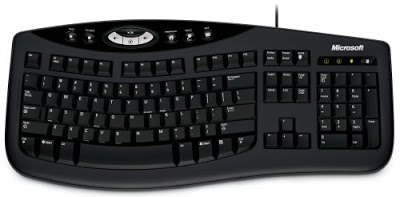
- flat with arc-shaped buttons, such as Microsoft Comfort Curve 2000

- flat, arc-shaped, separated (“broken”) for the right and left hands separately, such as, for example, Microsoft Natural Ergonomic Keyboard 4000
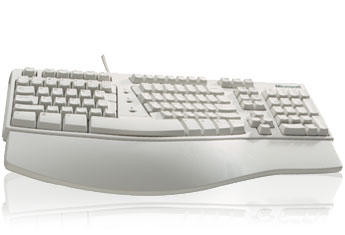
- vertically curved, arc-shaped, such as Microsoft Natural Multimedia or Microsoft Natural Keyboard Elite . Beware, however, of keyboards that are too curved in the vertical plane — it becomes completely inconvenient to work on them.
From personal experience, the latter type is clearly preferable - the hand is in a more natural position. The question of the natural position of the hand will be discussed in more detail in the chapter on mouse substitutes, but for now we will leave this statement at the level of a temporary axiom.
In addition to these, there are a number of "unusual" ergonomic keyboards, which I probably would have classified even as exotic:
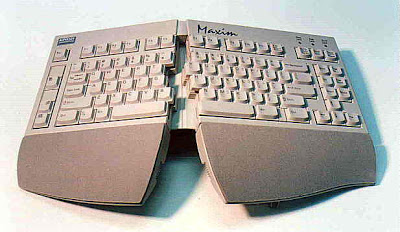
- adjustable split (physically into two halves) keyboard, such as Kinesis Maxim Adjustable Keyboard
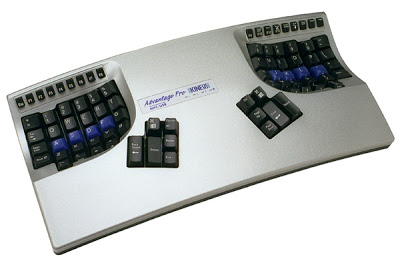
- a separate, concave-down keyboard, such as the Kinesis Ergonomic Contoured Keyboard or the Maltron Two Handed Keyboard . I read a few rave reviews about such keyboards, but no more. Neither my personal experience of using it, nor the experience of my closest associates, I can share with you, my dear readers, so the expediency of using such devices will remain questionable, especially since the price of such a piece is quite high - about $ 300- $ 600.
Regarding the usual mice, you can briefly give very few recommendations. First, the mouse should not be small, so that you have to hold it with your thumb and little finger, and secondly, it is desirable that the mouse be high enough to support the inner side of the palm, so that the latter does not have a canopy all the time. Slightly departing from the theme of the mice themselves, it's time to find out why the position of the hand when working with the mouse is problematic.
According to personal observations, which are partially confirmed by various publications that came to my eyes, the natural position of the hand and wrist when we stand will be 45 degrees to our thighs - not completely parallel to them, as well as not perpendicular. If you try to just stand up and freely give up, they will assume that very position.
Now, still standing, we will do a very simple act - bend your elbows, keeping your arms as relaxed as possible. Note that the wrists and wrists, which were at an angle to our body, now retain the same angle to the horizontal surface. If you rotate the hand along the longitudinal axis of the arms, so that the latter take a horizontal position, the bones of the forearm will not be parallel, as before.
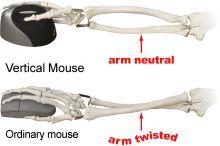
Also, our muscles and tendons will be more stressful than before. Note that it is in this position that our hands are at work with ordinary mice - this is the first of the two causes of the distressful condition of our hands after the N-th number of years of continuous work. We will talk about the second reason concerning the position of the fingers below.
Well, now the fun begins. Let's see what exactly we can replace these friendly-masculine tail creatures.
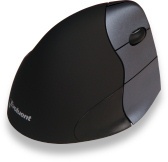 There is a rather unusual type of mice that tries to maintain the natural position of the hand and wrist in a horizontal position, offering to turn not our hands to the plane of the mouse, but the plane of the mouse to the position of our hands.
There is a rather unusual type of mice that tries to maintain the natural position of the hand and wrist in a horizontal position, offering to turn not our hands to the plane of the mouse, but the plane of the mouse to the position of our hands.
From personal experience, working with such a mouse relieves the burden on the mouse-holding hand and I can say that at least one of my colleagues such a mouse helped get rid of wrist pains at the initial level of the inflammatory process.
Another type of vertical mouse offers an even more unusual approach, not only turning the mouse up to the plane of the hand, but also replacing all movements with a brush with movements of the entire forearm.
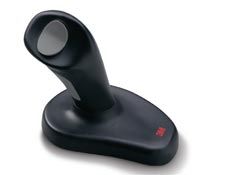 Based on my own experience, I can see that although working with such a mouse improves the position of the wrist, on the other hand our whole hand makes us move to move the cursor. In this situation, the load on the shoulder and the accompanying muscles increases, which negatively affects the whole process of work. I could not work with such a device because of the intense load on my shoulder, but I know one person who considers such a manipulator as the most correct alternative to an ordinary mouse.
Based on my own experience, I can see that although working with such a mouse improves the position of the wrist, on the other hand our whole hand makes us move to move the cursor. In this situation, the load on the shoulder and the accompanying muscles increases, which negatively affects the whole process of work. I could not work with such a device because of the intense load on my shoulder, but I know one person who considers such a manipulator as the most correct alternative to an ordinary mouse.
On sale you can find two types of trackballs - with a ball under the thumb and with a ball under the index, middle and nameless.
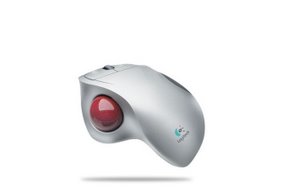
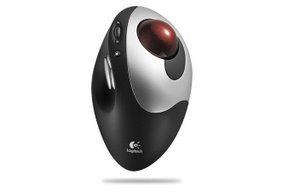
Having tried both one and the other, I cannot recommend either of them. Why, you ask. The answer is simple. When working with trackballs, neither the problematic position of the wrist on the table disappears, and the load on the fingers simply changes. In the first case, the thumb will be heavily loaded; in the second, all movements and clicks will be made with straightened fingers, which, as already mentioned, is often one of the components of our big problem.
 If we return for a second to the question of the natural position of the hand at the table, then we will find the only muscle-changing gadget that will not contradict the above principles, ... designers. It is this cohort of people who use graphic tablets, on which virtually everything that needs to be transferred to the screen is virtually drawn in a wireless “pencil”. If you look closely, then when sitting with the stylus, the hand in the sitting position repeats the free state of the hand and the palm - not parallel and not perpendicular to the body, but approximately 45 degrees to the surface of the table. In addition, our fingers, holding the stylus, are not fully extended, as when working with a normal or vertical mouse, but are in a half-bent state and, consequently, gain a little effort on gaining in a less stressful position.
If we return for a second to the question of the natural position of the hand at the table, then we will find the only muscle-changing gadget that will not contradict the above principles, ... designers. It is this cohort of people who use graphic tablets, on which virtually everything that needs to be transferred to the screen is virtually drawn in a wireless “pencil”. If you look closely, then when sitting with the stylus, the hand in the sitting position repeats the free state of the hand and the palm - not parallel and not perpendicular to the body, but approximately 45 degrees to the surface of the table. In addition, our fingers, holding the stylus, are not fully extended, as when working with a normal or vertical mouse, but are in a half-bent state and, consequently, gain a little effort on gaining in a less stressful position.
It will be useful to add that the most frequent action of the left “click” is replaced when working with the stylus by pressing on its virtual core (pressing the whole hand towards the tablet), bringing additional relief to our distressful hands. Right click is made by pressing the stylus button under the thumb, thus freeing the middle finger from the load.

Returning again and again to the bitter personal experience, I can see that working with such a device, you can stop the pain in the wrist and fingers almost instantly.
If you do not have the opportunity to change the mouse / keyboard to one of the ergonomic solutions described above, you can use a half-hearted approach - try to maintain the correct position of the hand when working with the wrong device. The correct position of the hand can be achieved with a medical elastic bandage supporting the hand and wrist. Not every bandage will be useful to us, but only containing a rigid or springy metal element.

Hard bandage
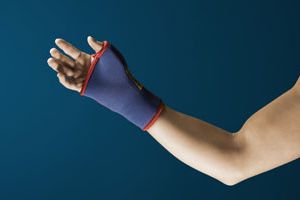
Bandage with spring element
According to experience, it is quite convenient to work with both pockets of dressings, except that the first option provides less freedom of the hand, which, however, is hardly a drawback for our case. An example of such Uriel dressings can be seen here and here .
Such a solution can be recommended to those who are forced, for one reason or another, to continue working with the mouse and cannot change this input device to a more correct and safe for health.
As another solution for replacing the mouse, we can mention an external touchpad (usually USB). Such a device, although it may to some extent be an alternative solution, but from the experience of working on a laptop, is not sufficiently effective. Despite the fact that hand movements will be limited, the position of the wrist on the table will still be problematic, and the fingers will be strained for tracking.
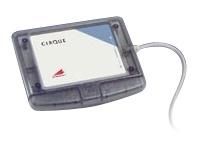
In conclusion, you can say only one very simple truth - take care of yourself. No one will ever know and feel what exactly is happening to you every day. If you feel that a problem occurs during work - do not ignore it. The sooner you take up her decision, the less blood will cost you, since most of the possible solutions and procedures I tried to describe in sufficient detail, but simply and without unnecessarily tiring details.
I don’t know how to properly finish such a long narrative, so I just hope that everything that was described above will help you in one way or another. Bye.
In this article we will try to understand the causes of tunnel syndrome, possible ways of treatment and ways to prevent this undesirable phenomenon. This article will contain quite a few subjective deviations from the formal definitions and formulations that are available on various medical sites, since spending a lot of time behind the keyboard over the past eight years, I have tasted the effects of tunnel syndrome in all its manifestations.
How does the tunnel syndrome develop and how do we feel
So, what causes this unpleasant phenomenon? Carpal (tunnel) syndrome is caused by squeezing the nerve of the hand (median nerve), which passes through special channels formed by the bones and ligaments. Naturally, when squeezing the nerve, we feel pain, which can be felt in the joint of the hand, but not only in it. Now we will go through all the stages of the discussed syndrome and try to connect the physiological processes with what we can feel when working at the computer.


From personal experience, first there is a slight dull pain, numbness or discomfort in the joint of the hand after several hours of work. If you stop work and just stretch your arms, the pain disappears for half an hour - an hour. The unchanging position of the hand, along with intensive work, leads to stagnation of blood, which causes only unpleasant sensations at this stage.
')
If you do nothing and continue to work as before, then after a year or two the next stage will come - a burning sensation in the brush, which appears by the end of the working day and no longer passes as before, but continues to haunt us at home, two or three hours, moving gradually just dull, weak pain. This happens because of the thickened tendons, which are already inflamed and begin to put pressure on the nerve (the diameter of the channel has decreased) with a problematic position of the hand. At about the same time, pain may appear in the hand itself (the outer side of the palm) and in the phalanges of the fingers, especially the index and middle, which are most used when working with the mouse.
In addition to all the charms of working at a standard place of work, it becomes problematic to lift weights when the brush is in a certain position. Interestingly, the degree of pain does not depend on the severity of the load, but mainly only on the position of the arm. But we will not be distracted, we will go further.
In this position, our body will try to cope with an unfavorable position, and lymphatic fluid begins to accumulate between cartilage, designed to flush out the affected and inflamed cells. In the normal course of events, such a process reaches its goal (the cells are washed out) and the liquid dissolves itself. If the load on the hands is long, then inflammation, as you can already guess, does not stop, but quite the opposite. With this development of events, the natural treatment process itself can already lead to the opposite result - swelling of the lymphatic fluid in the joints. From personal experience, again, it can be determined with a high probability whether you have reached this stage or not. Tides of lymphatic fluid are most significant at night, so if the pain at night is stronger, you have already arrived at the destination station. Well, if the pain in the joints also wakes you up at night - “dry the oars, gentlemen,” it's time to do something urgently, otherwise the only way out will be an operation.
Before we discuss inpatient medical treatment, let's first see what we can do on our own, reduce the healing of our body to physiotherapy, or, in extreme cases, limit ourselves to outpatient treatment.
Exercises to prevent tunnel syndrome
These exercises can / should be done every few hours, and each of them should be repeated many times, with a dozen or two.

1. Strongly squeeze the fingers into a fist and also strongly release.

2. Clench fists and rotate first in one direction, then in the opposite direction.

2a You can perform the same exercise with a special ball, inside which is a fast-rotating disk (for example, PowerBall or with any more or less heavy object). I had the opportunity to try such a thing — it resists noticeably changing the position of the ball along any axis, and thus trains the muscles and accelerates the blood more, which is what we achieve. You can rotate the hand not only along the axis of the elbow-wrist, as shown in the picture, but also completely arching the hand.

3. Press your palms together, spread your elbows to the sides, assuming a position like a prayer. Forearms in this position are parallel to the floor. Then, try to lower the palms as low as possible without opening them and leaving the elbows still high. It is likely that there will be pain in the hands, in the palms or even in the phalanges of the fingers, if the disease under discussion has already reached you. It is important not to put your hands far away from yourself.



4. If you have a special soft ball (these are often distributed as free gifts at various gatherings and presentations) for hands, press it alternately with your fingers, palm and between your hands, as shown in the pictures.

5. Repeat the previous exercise, but without the ball, resisting the thumb with all your fingers in turn.

6. Straightening your arms in front of you, as shown in the picture, rest your hand on the palm. When resisting, try to straighten a bent palm.
It seems so far. Let's go further - what can be done at home, if the pain is noticeable when working, i.e. (see previous chapter) tendons are already inflamed.
Exercises for the treatment of tunnel syndrome at home
The exercises that will be described here will border a little on “real” physiotherapy, but please tell me, why should we wait for someone and something if we can help ourselves? So let's start with the easiest, but again, from personal experience, the most effective.
1. Fill a deep bath with warm, almost hot, water and clenched fists, slowly rotate them in water. It is important that the water warms the hands high enough, above the hand joint. This exercise greatly relieves pain both at the initial stage and at the progressive stage. The optimal duration for this exercise is 10-15 minutes, no less. At the end, wrap your hands, including brushes, in a towel - do not cool them quickly. If the apartment is cold enough, then use even a warm scarf.
2. Repeating to some extent the previous exercise, you can put on the night alcohol warming compress, just do not make it strong, and then burn the skin on your hands - a most unpleasant experience.
3. Massage. In a situation where fingers and hands hurt from any effort, it will be difficult to massage yourself. It is best to ask someone, it does not require special skills, the main thing - the desire. It is necessary to massage the whole arm, starting from the outside of the palm, continuing upwards, the outer side of the forearm (trying to move in the middle of the arm, where there is a small cavity between the forearm bones).
4. I cannot say anything about the advice in this paragraph, neither for nor against, because I did not use this approach. If it helps you - well, if not - do not worry, water massage, namely, it will be discussed now, does not carry anything destructive. Hydromassage is offered as a treatment on some sites dedicated to this issue, and it is proposed to use it twice a day - in the morning (cool and warm water) for massaging the collar back, shoulder blades, shoulders, forearms and hands, and in the evening (only warm water) in the same way.
Physiotherapy exercises for the treatment of tunnel syndrome
We are starting to quietly cross the border of self-treatment and outpatient treatment, because physical therapy, although not an active treatment, at least in my opinion, is nevertheless prescribed by a physician, and physiotherapy should be fully completed to achieve some kind of sane result. Everything that will be described in this chapter should not be taken as the recommended course of treatment, and all the more I hope that everyone understands that my personal experience does not in any way replace the full-fledged prescription of a doctor, a specialist in this matter, and responsible for the result thereof .
1. Again ... massage. Yes, as one of the means, physiotherapy will offer you a massage again. I do not know how much his location affects the quality of massage (in his office or at home), he helped me a little in both the first and second cases.
2. Warming paraffin baths. Remember the first paragraph of the home exercises? It is almost the same, but instead of hot water, you will be offered to dip your hands in hot paraffin and after two or three dipping they wrap their hands with a warm towel. The result will be the same - the joint and the tendons warm up, only here your hands will look like big ritual candles. There is nothing terrible in it, on the contrary, it is funny then to make such hand casts in a scale of 1: 1.
3. Shortwave heating. With this type of treatment, the joints of the hand are heated by radiation in the range of several giga-hertz (if I remember everything correctly). I did not like this business and I refused after one session. The personal microwave on my hands did not seem to me to be particularly useful, and deep warming can be achieved at home.
4. Exercises for the muscles of the arms and back. Sometimes the disease under discussion may occur due to improper posture during work, therefore, as one of the options for physiotherapy, you can be offered simple physical exercises, it all depends on your physique and posture. Since the proposed exercises are quite simple, there is not much point in describing them in detail. Yes, in my opinion, this item is quite a candidate for a transfer to the previous chapter - at home you can certainly wave with light dumbbells and stretch the gum.
Hospital treatment
Unfortunately, although most likely the opposite, I can not share personal experience in the issue of inpatient treatment. As far as I know, when edema of the lymphatic fluid, doctors suggest a puncture - an operation to extract excess fluid. Personally, this does not seem to me to be 100% correct, since the consequences, rather than the original cause, are eliminated. With completely neglected cases when the cartilage of the joint has been damaged or destroyed, various medications are offered, but this certainly requires an examination by a specialist, therefore our discussion of inpatient treatment will end approximately here.
Gadgets saving us
We couldn’t call ourselves geeks if we had a pair of labeled aces up our sleeves to help us solve such problems, wouldn’t we? Well, if so, then it’s time to discuss and tell which gadgets are saving us in this position.
Prophylactic
The easiest and most effective way to solve a problem is not to face it. The easiest way, fairly well known today, is a pad under the brush. The most commonly used gel pads and, it should be noted that even the cheapest of them do their job perfectly, straightening our joint of the brush as far as possible.

So wrong.

And so right.
But let's move on to more serious devices, and we'll start with keyboard modifications.
Ergonomic (Natural) Keyboard
To date, there are three types of conventional ergonomic keyboards:

- flat with arc-shaped buttons, such as Microsoft Comfort Curve 2000

- flat, arc-shaped, separated (“broken”) for the right and left hands separately, such as, for example, Microsoft Natural Ergonomic Keyboard 4000

- vertically curved, arc-shaped, such as Microsoft Natural Multimedia or Microsoft Natural Keyboard Elite . Beware, however, of keyboards that are too curved in the vertical plane — it becomes completely inconvenient to work on them.
From personal experience, the latter type is clearly preferable - the hand is in a more natural position. The question of the natural position of the hand will be discussed in more detail in the chapter on mouse substitutes, but for now we will leave this statement at the level of a temporary axiom.
In addition to these, there are a number of "unusual" ergonomic keyboards, which I probably would have classified even as exotic:

- adjustable split (physically into two halves) keyboard, such as Kinesis Maxim Adjustable Keyboard

- a separate, concave-down keyboard, such as the Kinesis Ergonomic Contoured Keyboard or the Maltron Two Handed Keyboard . I read a few rave reviews about such keyboards, but no more. Neither my personal experience of using it, nor the experience of my closest associates, I can share with you, my dear readers, so the expediency of using such devices will remain questionable, especially since the price of such a piece is quite high - about $ 300- $ 600.
Mice and Mouse-like
Regarding the usual mice, you can briefly give very few recommendations. First, the mouse should not be small, so that you have to hold it with your thumb and little finger, and secondly, it is desirable that the mouse be high enough to support the inner side of the palm, so that the latter does not have a canopy all the time. Slightly departing from the theme of the mice themselves, it's time to find out why the position of the hand when working with the mouse is problematic.
According to personal observations, which are partially confirmed by various publications that came to my eyes, the natural position of the hand and wrist when we stand will be 45 degrees to our thighs - not completely parallel to them, as well as not perpendicular. If you try to just stand up and freely give up, they will assume that very position.
Now, still standing, we will do a very simple act - bend your elbows, keeping your arms as relaxed as possible. Note that the wrists and wrists, which were at an angle to our body, now retain the same angle to the horizontal surface. If you rotate the hand along the longitudinal axis of the arms, so that the latter take a horizontal position, the bones of the forearm will not be parallel, as before.

Also, our muscles and tendons will be more stressful than before. Note that it is in this position that our hands are at work with ordinary mice - this is the first of the two causes of the distressful condition of our hands after the N-th number of years of continuous work. We will talk about the second reason concerning the position of the fingers below.
Well, now the fun begins. Let's see what exactly we can replace these friendly-masculine tail creatures.
Vertical Mice - 1
 There is a rather unusual type of mice that tries to maintain the natural position of the hand and wrist in a horizontal position, offering to turn not our hands to the plane of the mouse, but the plane of the mouse to the position of our hands.
There is a rather unusual type of mice that tries to maintain the natural position of the hand and wrist in a horizontal position, offering to turn not our hands to the plane of the mouse, but the plane of the mouse to the position of our hands.From personal experience, working with such a mouse relieves the burden on the mouse-holding hand and I can say that at least one of my colleagues such a mouse helped get rid of wrist pains at the initial level of the inflammatory process.
Vertical mice -2
Another type of vertical mouse offers an even more unusual approach, not only turning the mouse up to the plane of the hand, but also replacing all movements with a brush with movements of the entire forearm.
 Based on my own experience, I can see that although working with such a mouse improves the position of the wrist, on the other hand our whole hand makes us move to move the cursor. In this situation, the load on the shoulder and the accompanying muscles increases, which negatively affects the whole process of work. I could not work with such a device because of the intense load on my shoulder, but I know one person who considers such a manipulator as the most correct alternative to an ordinary mouse.
Based on my own experience, I can see that although working with such a mouse improves the position of the wrist, on the other hand our whole hand makes us move to move the cursor. In this situation, the load on the shoulder and the accompanying muscles increases, which negatively affects the whole process of work. I could not work with such a device because of the intense load on my shoulder, but I know one person who considers such a manipulator as the most correct alternative to an ordinary mouse.Cat Mice: Trackballs
On sale you can find two types of trackballs - with a ball under the thumb and with a ball under the index, middle and nameless.


Having tried both one and the other, I cannot recommend either of them. Why, you ask. The answer is simple. When working with trackballs, neither the problematic position of the wrist on the table disappears, and the load on the fingers simply changes. In the first case, the thumb will be heavily loaded; in the second, all movements and clicks will be made with straightened fingers, which, as already mentioned, is often one of the components of our big problem.
Anti-mouse: Virtual Pencils / Graphic Tablets
 If we return for a second to the question of the natural position of the hand at the table, then we will find the only muscle-changing gadget that will not contradict the above principles, ... designers. It is this cohort of people who use graphic tablets, on which virtually everything that needs to be transferred to the screen is virtually drawn in a wireless “pencil”. If you look closely, then when sitting with the stylus, the hand in the sitting position repeats the free state of the hand and the palm - not parallel and not perpendicular to the body, but approximately 45 degrees to the surface of the table. In addition, our fingers, holding the stylus, are not fully extended, as when working with a normal or vertical mouse, but are in a half-bent state and, consequently, gain a little effort on gaining in a less stressful position.
If we return for a second to the question of the natural position of the hand at the table, then we will find the only muscle-changing gadget that will not contradict the above principles, ... designers. It is this cohort of people who use graphic tablets, on which virtually everything that needs to be transferred to the screen is virtually drawn in a wireless “pencil”. If you look closely, then when sitting with the stylus, the hand in the sitting position repeats the free state of the hand and the palm - not parallel and not perpendicular to the body, but approximately 45 degrees to the surface of the table. In addition, our fingers, holding the stylus, are not fully extended, as when working with a normal or vertical mouse, but are in a half-bent state and, consequently, gain a little effort on gaining in a less stressful position.It will be useful to add that the most frequent action of the left “click” is replaced when working with the stylus by pressing on its virtual core (pressing the whole hand towards the tablet), bringing additional relief to our distressful hands. Right click is made by pressing the stylus button under the thumb, thus freeing the middle finger from the load.

Returning again and again to the bitter personal experience, I can see that working with such a device, you can stop the pain in the wrist and fingers almost instantly.
Semi-medical solutions: elastic dressings
If you do not have the opportunity to change the mouse / keyboard to one of the ergonomic solutions described above, you can use a half-hearted approach - try to maintain the correct position of the hand when working with the wrong device. The correct position of the hand can be achieved with a medical elastic bandage supporting the hand and wrist. Not every bandage will be useful to us, but only containing a rigid or springy metal element.

Hard bandage

Bandage with spring element
According to experience, it is quite convenient to work with both pockets of dressings, except that the first option provides less freedom of the hand, which, however, is hardly a drawback for our case. An example of such Uriel dressings can be seen here and here .
Such a solution can be recommended to those who are forced, for one reason or another, to continue working with the mouse and cannot change this input device to a more correct and safe for health.
Touchpad as another solution
As another solution for replacing the mouse, we can mention an external touchpad (usually USB). Such a device, although it may to some extent be an alternative solution, but from the experience of working on a laptop, is not sufficiently effective. Despite the fact that hand movements will be limited, the position of the wrist on the table will still be problematic, and the fingers will be strained for tracking.

Conclusion
In conclusion, you can say only one very simple truth - take care of yourself. No one will ever know and feel what exactly is happening to you every day. If you feel that a problem occurs during work - do not ignore it. The sooner you take up her decision, the less blood will cost you, since most of the possible solutions and procedures I tried to describe in sufficient detail, but simply and without unnecessarily tiring details.
I don’t know how to properly finish such a long narrative, so I just hope that everything that was described above will help you in one way or another. Bye.
Source: https://habr.com/ru/post/40692/
All Articles